How Brands Are Using Your Selfie for Marketing


I only got 10 likes in the last five minutes--“#Selfie,” by the Chainsmokers
Do you think I should take it down?
Let me take another selfie. . .
Most of us who live on social media know that companies such as Instagram allow you to use their services on the condition that they can use your services, royalty-free, without any notification.
That was one reason why I avoided using Instagram at first, although almost 6,500 photos later, I got over those privacy concerns pretty quickly. Not that anyone would want to use photos of my dog, my dome smooshed into a bike helmet, or me doing a yoga backbend in front of the Taj Mahal. Maybe. But I also do not pose for selfies brandishing my middle finger, with my tongue wagging out, or passed out buried in a pile of empty Corona bottles (I only drink local or organic brews). Triple Pundit doesn’t need the embarrassment, nor do any of my business clients. But for those of you that love to post pics of your shopping expeditions or favorite junk foods, be aware: Your selfie could very well be dissected and analyzed by the digital marketing startup Ditto.
And why wouldn’t any company use Ditto from a business perspective? The world of advertising and marketing has become murkier as more of us watch television at our convenience, not the networks’. That is, if you even watch television, chances are you spend more time flipping through YouTube videos or catching Netflix on the tablet. Why even contact a company over an issue, big or small, by snail mail or even an email when you can call them out on Twitter or Instagram? Gauging consumers’ thoughts of a brand, from the Boston Red Sox to Kraft Macaroni and Cheese, is becoming a tougher task. And so in comes Ditto with its online tools, which are creepy and brilliant at the same time.
The way Ditto works is not that complicated — it generates one of the forehead-slapping moments that make you think, “Why didn’t I think of that and score a few million bucks in venture capital funds?” Ditto uses an image recognition technology in order to evaluate how a product or brand is resonating with consumers — therefore going beyond those hashtags and text searches. And in a move that may excite or terrify you depending on your desire for privacy, the service even identifies potential “brand ambassadors.”
For those of you curious who is “hot or not” today, check out Ditto’s live stream. Not surprisingly, yesterday’s brand champs were Adidas and Barcelona FC. Apparently, those misspelled names on Starbucks’ cups made the coffee champ a weak performer. And hilariously, Twitter and Instagram were laying the biggest branding eggs. JuicyCouture must have a new product out, because its selfie performance was off the charts; Chanel, however, was tanking. According to the Wall Street Journal, Ditto can recognize as many as 3,000 logos — as well as smiles, weather, and objects from beer bottles to skis — allowing Ditto’s platform to analyze how and when a brand is being enjoyed or consumed.
Ditto’s technology may alarm those who resent the fact they may be a walking laboratory for brands. Critics say companies such as Instagram, Pinterest and Tumblr are not doing enough to advise their users on how their content is being used. But my response to that howling is that there is always an interesting correlation between those who criticize social media companies the most — and those who in turn live on those channels with the most frequency. The reality is: Do not count on any government agency clamping down on these usage policies anytime soon. The best solutions are to jump off these channels, be careful about what you post, or as in my case with Facebook, be coy about what you like. Based on my “likes,” Facebook always shows me testimonials related to tampons, the NRA and the Tea Party. Enough said.
Image credit: Leon Kaye
After a year in the Middle East and Latin America, Leon Kaye is based in California again. Follow him on Instagram and Twitter. Other thoughts of his are on his site, greengopost.com.
How to Become a B Corp in Six Weeks or Less
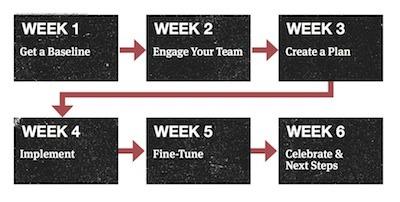

This is the tenth in a weekly series of excerpts from the new book The B Corp Handbook: How to Use Business as a Force for Good (Berrett-Koehler Publishers, October 13, 2014). Click here to read the rest of the series.
Welcome to a six-week, turbocharged Quick Start Guide to becoming a Certified B Corporation.
The size and complexity of your company will affect how quickly you can move through the steps to B Corp certification. For example, smaller companies — especially service companies or companies without outside investors — should be able to move through the Quick Start Guide in less than six weeks. Larger companies with a sizable number of employees and/or departments will probably need the full six weeks or more.
In my experience, you will have the best chance of successfully completing the certification process if:
- You have the ability to see that “the perfect is the enemy of the good.” If you try to be perfect on the B Impact Assessment, you run the risk of getting bogged down and never finishing. Aim for good enough and continue to improve your score in the future.
- You or someone else in your company “owns” the project. If many people are working on a project, it often means that no one is actually responsible for moving it forward. Make sure that someone (whether it is you, an external consultant or another employee) has taken ownership of the project and will dedicate the time and energy necessary to see it through to completion.
- You have access to financial, worker, supplier, community and environmental data. If you don’t personally have access to this data, you need access to the people who are responsible for this data (e.g., the facility manager for energy usage or the human resources manager for employee metrics).
Finally, do not automatically assume that planning for six weeks is too aggressive to complete this process. Try keeping everything to a tight schedule and adjust as needed. You might be surprised at how much you can get done in a short time.
Week 1: Get a baseline
Time Estimate: 90 minutesOBJECTIVE: The objective during week 1 is to use the B Impact Assessment to establish a quick baseline of your company’s overall social and environmental performance and to create momentum before engaging others in the process.
END RESULT: A rough B Impact Report for your company.
- Clear your schedule. Clear an uninterrupted ninety-minute slot on your calendar. If it is too difficult to set aside one block of time, consider three 30-minute slots. The point is that you need some focused time.
- Create your B Impact Assessment account. Create your free account online at bimpactassessment.net. As you register, you will be asked questions about your company’s size, industry, and location in order to generate a version of the assessment that is tailored to fit your business. For example, a marketing company with six employees will get different questions than a furniture manufacturer with 6,000 employees.
- Ready, set, go! Begin working through the assessment. Remember, on this first attempt, to estimate your answers and to avoid spending more than a minute or two on any particular question. The goal is to get a rough baseline of your practices in 90 minutes or less. There are five sections: Governance, Workers, Community, Environment, and Impact Business Models. If you don’t make it through all five in 90 minutes, don’t worry. Clear another thirty minutes on your calendar later in the week to complete what is left.
- Review your preliminary score. At the end of your first trial run, you will receive a baseline B Impact Report that will give you a snapshot of your company’s overall social and environmental performance. This report will also contain benchmarks so that you can compare your performance to more than fifteen thousand other businesses that have completed the assessment.
- Did you score 40 to 60? An overall B Impact Score of 40 to 60 is average.This means you’ve got a solid foundation on which to build. The fun part will be working with your colleagues to determine which impact areas (i.e., governance, workers, community, or environment) you want to improve.
- Did you score 60 to 80? If you received an overall B Impact Score of 60 or higher, nice work! It sounds like your company has already adopted quite a few socially and environmentally responsible practices. From here, your goal will be to help mobilize your team to improve your performance in the areas that matter most to you and your company.
- Did you score 80 or higher? If you received an overall B Impact Score of 80 or higher, congratulations! Eighty is the minimum score necessary for B Corp certification. If you are interested, I highly recommend that you consider pursuing B Corp certification to give your company the recognition it deserves.
- Regardless of your initial overall score, remember that this is a journey of continuous improvement. Are there areas you and others in your company should be proud of? Are there areas you would like to work on? This will give you a few things to think about as you move forward into week 2.
Coming next week: Week 2: Engage Your Team
Ryan Honeyman is a sustainability consultant, executive coach, keynote speaker, and author of The B Corp Handbook: How to Use Business as a Force for Good. Ryan helps businesses save money, improve employee satisfaction, and increase brand value by helping them maximize the value of their sustainability efforts, including helping companies certify and thrive as B Corps. His clients include Ben & Jerry’s, Klean Kanteen, Nutiva, McEvoy Ranch, Opticos Design, CleanWell, Exygy, and the Filene Research Institute.
To get exclusive updates and free resources about the B Corp movement, sign up for Ryan’s monthly newsletter. You can also visit honeymanconsulting.com or follow Ryan on Twitter:@honeymanconsult.
Unilever and WRI Partner to Stall Global Deforestation

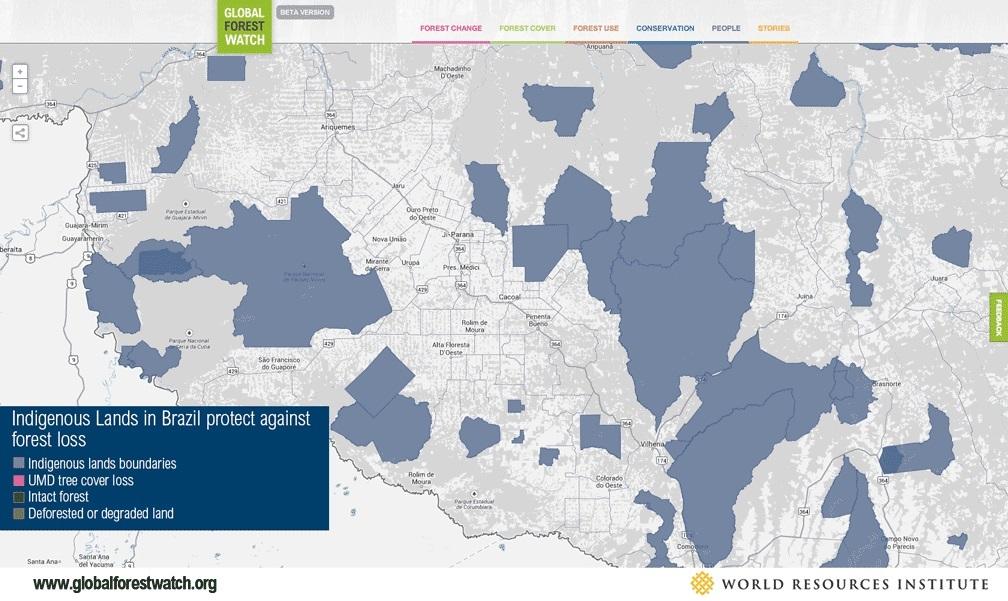
One of the more welcome trends in recent years is the increase in partnerships between NGOs and businesses to work on sustainability challenges. The nonprofit has the expertise and capacity to work on issues from water to land rights; companies in turn have the funds, technology or brand recognition that can help raise awareness and scale these programs. One of the latest high-profile partnerships is between Unilever and the World Resources Institute (WRI), which have worked together to further a much needed agenda: increase transparency in agricultural supply chains to stall the pace of deforestation.
WRI has long included deforestation within its body of work, which makes it a natural fit to partner with a company such as Unilever, which uses palm oil in many of its products. And the growing demand for palm oil over the past decade is one of the major factors behind global deforestation. Despite growing awareness about deforestation’s catastrophic effects, the felling of trees, mostly to create farms and pastureland, continues. In fact, University of Maryland study suggests the rate of forests lost between 2010 and 2012 was the equivalent about 50 soccer fields every minute of every day — over a span of 12 years. Last month’s Climate Summit in New York resulted in a pledge to restore 350 million hectares of forest worldwide by 2030, a massive undertaking considering that landmass is about the size of India. So, can the Unilever-WRI alliance help?
According to both organizations, their joint effort, the Global Forest Watch Commodities Platform, can help companies analyze the effects commodities have on forests. Working with additional organizations including Google, ESRI and ScanEx, Global Forest Watch uses “big data” to allow a company to fine tune its supply chain through the use of satellite maps and other information. Companies can locate areas where palm oil production has contributed to forest loss — and in turn locate credible sustainable palm oil producers. Data is also available that can help companies evaluate the effects other commodities, including soy, beef, and pulp and paper, have on global forests. And considering the risks drought and fires have had on global supply chains, a new tool that monitors fires (for now monitoring only southeast Asia) should prove useful as well.
So whether a company is finally responding to stakeholder pressure to clean up their global operations, or are assessing global risks for a sustainability report, tools such as the Global Forest Watch platform are a step towards nudging companies to clean up their act worldwide. After all, protecting forests is more than preserving wildlife and the environment; they are the world’s lungs, provide livelihoods for as many as 1.6 billion people and are an integral part of the global economy — but will not be for long if they continue to be mismanaged. And just as important, such tools as the Global Forest Watch will keep corporations accountable. The old excuse of “we had no idea our suppliers were doing this” no longer applies — information on what is happening to our planet is out there, it’s readily available, and can be tracked by anyone.
Image credit: WRI
After a year in the Middle East and Latin America, Leon Kaye is based in California again. Follow him on Instagram and Twitter. Other thoughts of his are on his site, greengopost.com.
SXSW Eco Interview: Alejandro Rios, Masdar Institute


This post is part of Triple Pundit’s ongoing coverage of the SXSW Eco conference. For the rest, please visit our SXSW Eco page here.
We've been following Masdar Institute for some time on 3p, which meant I was particularly pleased to talk to Dr. Alejandro Rios last week at SXSW Eco. Specifically, we talked about a new project called ISEAS, which stands for "Integrated Seawater, Energy and Aquaculture System." The concept is every bit as interesting as the acronym suggests. Take the challenges of feeding people, producing clean energy and dealing with scarce fresh water, and engineer a solution for all three. It may be a tall order, but the ISEAS project proposes to do exactly that.
In a nutshell, Masdar Institute is attempting to use halophytes (plants that grow in seawater) to produce biofuels while at the same time filtering the pollutants associated with growing fish or shrimp in aquaculture ponds. The benefits are potentially huge:
- The process uses only salt water, which is plentiful -- even in Abu Dhabi -- thus eliminating any debate about whether it wastes water.
- The halophytes will also eliminate waste from the aquaculture -- a major problem in traditional shrimp farming operations.
- Useful biofuel will be produces when plants are harvested -- possibly even jet fuel.
- The whole thing is a carbon sink with a negative carbon footprint.
Granted, it's all just an experiment at this point, but in the video below, Dr. Rios explains the basics...
Lego to End Partnership with Shell


Lego recently announced that it will not renew its contract with Shell when it ends in 2016. “We want to clarify that as things currently stand we will not renew the co-promotion contract with Shell when the present contract ends,” the company said in a statement released last week. The announcement comes after a three-month-long campaign by the environmental group, Greenpeace. The group set its sights on Lego, demanding that the toy company drop its partnership with Shell.
The company made it clear that it did not like the campaign by Greenpeace. Instead of a campaign targeting the company, Greenpeace should have had “direct conversation with Shell,” Jørgen Vig Knudstorp, president and CEO of the Lego Group, said in a statement by the company. Knudstorp added that Lego does not “want to be part of Greenpeace’s campaign, and we will not comment any further on the campaign.”
Greenpeace's public request to Lego shows just how viral a campaign can go these days when most folks have Facebook profiles and Twitter accounts. The environmental group created a petition titled Cut Ties With Shell. The petition stated that Shell is “mobilizing giant oil rigs” in the Arctic to drill for oil and that would put the lives of native wildlife such as polar bears and beluga whales at risk. It asked Lego to “take a stand against Arctic destruction” and not let its “good name be used to legitimize what cannot be legitimized.”
But the Greenpeace campaign consisted of more than just an online petition, as a blog post by the group shows. Here are other parts of the campaign:
- The most viral video by Greenpeace in its history. The video depicts an Arctic oil spill using Lego toys and a sad rendition of a popular song. The end of the video features a link to the petition.
- Giant Arctic animals built by children from Lego toys on the front of Shell’s London headquarters to protest Lego’s partnership with Shell.
- Protests by activists using miniature Lego people, called Lego-lution.
- At a Shell gas station in Legoland in Billund, Denmark, activists used tiny Lego climbers to hold a protest.
- Over a million people globally emailed Lego and asked the company to end its partnership with Shell.
Back in July, Shell responded to the Greenpeace campaign with a statement by Knudstorp that stated: “Shell lives up to their responsibilities wherever they operate and take appropriate action to any potential claims should this not be the case.” Greenpeace responded in a blog post to the statement, countering that “there is ample evidence that Shell is not able to operate legally, or safely, in the Arctic.” The blog post cited “crashed oil rigs, blazing drill ships, crushed-like-a-beer-can emergency equipment, Alaskan tax dodges and ignored safety warnings.” Greenpeace also pointed out in the post that associating with Shell is “contrary to the very high environmental standards at the heart of who Lego are.”
If companies can learn one thing from the campaign it's that just releasing a statement condemning the campaign won't work. Groups like Greenpeace have a global reach that, combined with social media, make campaigns go viral very quickly. Many people are concerned about the environment and will decide to take part in a campaign. Opening dialogue with the environmental group goes a long way and would only strengthen a company's sustainability program.
Image courtesy of Greenpeace Lego-lution
New £500m joint venture to reinvigorate onshore wind


In a major boost for the onshore wind power industry, Britain’s green energy company Ecotricity and global construction and development firm Skanska are forming a joint venture – called Skylark – to build wind farm projects in Britain.
Skylark will draw on the expertise of Ecotricity in developing green energy projects through planning, while Skanska will utilise their expertise in construction and engineering.
The joint venture will aim to put 350MW of new green energy projects into planning system in the first 5 years, which would represent a potential investment of £500m should the projects be consented, supplying green electricity to 200,000 homes.
Three development sites have already been identified for Skylark’s first round of investment, representing around 100MW of generating capacity, with the target of delivering new renewable energy capacity for Britain as early as 2018.
Skylark will also create a range of new jobs, from planning experts through to scientific, technical, construction and maintenance roles.
Ecotricity is a ‘not-for-dividend’ enterprise that operates a ‘bills into mills’ business model – that uses customers’ energy bills to fund the building of new sources of green energy.
Renewable energy bodies outgrow affiliation


The Renewable Energy Association (REA) and Solar Trade Association (STA) are to go their separate ways, ending their formal four-year affiliation.
The two associations became affiliated in March 2011, when the STA merged with the REA's Solar Power Group and relaunched with representation of both the solar heating and solar power industries.
Next year the two associations will become independent once again, allowing them both to focus on their core strengths.
REA Chairman Martin Wright explained: “Solar heating and solar power are vitally important technologies, with the potential to reduce energy costs for UK households and businesses. Our members want us to strengthen our offer for these important technologies. This is what we're going to do, by building on the excellent capacity in our existing On-site and Renewable Power sector groups. We will continue to apply our unparalleled policy expertise and strong relations with Government to the goal of securing a bright future for UK solar energy.
STA Chairman Jan Sisson added: “Solar power has come from nowhere at the start of this Parliament to providing nearly 10% of all renewable power over the last quarter. As long as we can secure a more stable policy framework, subsidy-free solar is now on the horizon.”
The Carbon for Water Program's Impact in Rural Kenyan Homes
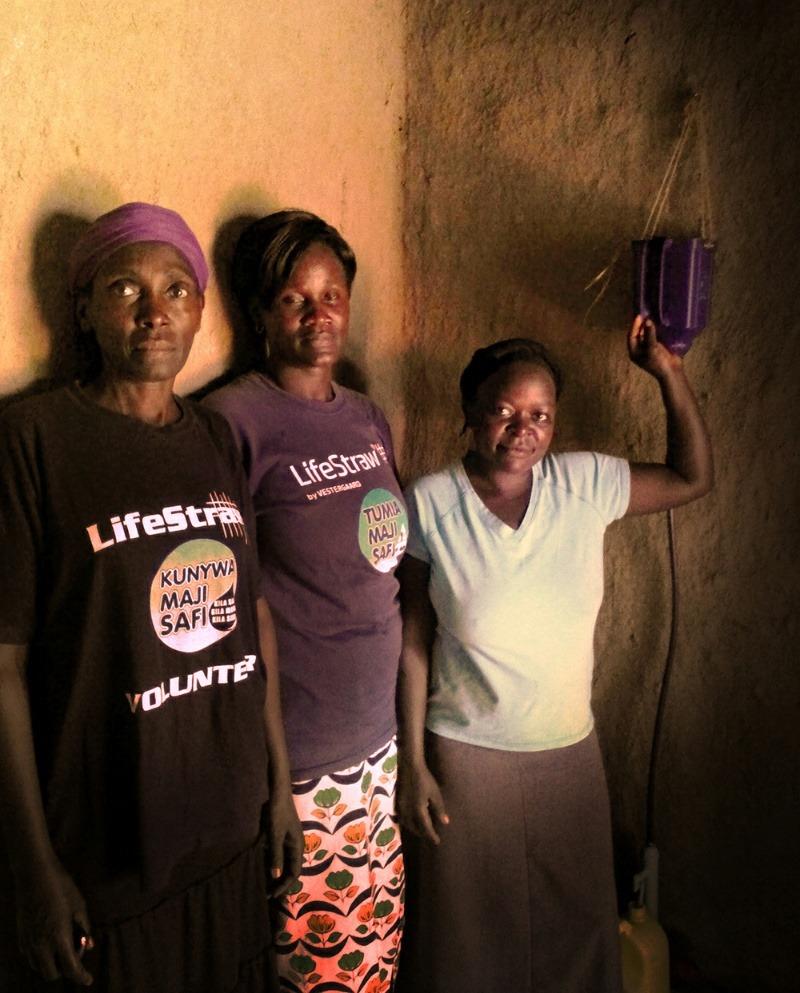

Editor's Note: Triple Pundit's RP Siegel visited Kenya to learn more about the LifeStraw Follow the Liters campaign. This is the second post from his trip. In case you missed it, you can read the first post here.
Last week, I described a school visit, in which the team introduced a number of LifeStraw Community Filters -- provided by the Follow the Liters Campaign that just kicked off this week. The program will provide clean water to 125,000 school children in western Kenya.
On Friday, I made a number of home visits with Steve Otieno, Vestergaard's country director for climate & water in Kenya. Steve manages the Follow the Liters campaign here. He also managed the Carbon for Water program, which, funded by carbon credits that were administered by Climate Care, provided nearly 900,000 LifeStraw family filters back in 2011. The company maintains a staff in the area, who, assisted by a large volunteer force, makes regular home visits to ensure that the families are using the filters properly and are having no issues with them.
The company had hoped that after the pilot was completed, the program would continue to expand across Kenya. But the carbon market, which drives the program, has not kept pace. Now they are looking into other funding sources including local governments.
At the opening ceremony on Monday, Steve said, "We have been a family, but now we are a community." Over these past few days I have come to see the meaning behind these words.
The first home we visited belonged to Demaris Saswani, who lives with two children and six grandchildren all enrolled in school. The house was built by her late husband who worked for the power company. She said that since they received the filter three years ago, none of them have been sick. Before that time, they had to boil the water and if they didn't, they got sick. The children do not have a filter at school, so she makes sure that they each carry a bottle of clean water with them.
Next, we visited Canary Omusinde, who lives with her husband and baby. They have also had very good results and no problems with the filter. She says that she typically makes three trips to the river with a 20-liter gerry can, though on wash days, she might take five trips. Fortunately, the river is only five minutes away. Like many in this area, the kitchen is outside to avoid the pollution. They get whatever food they don't grow themselves from the local market. I asked Canary if she knew what she was named after. When she said no, I showed her a picture of the bird in a book I had with me, which brought a smile to her face. "Now I know where my name comes from," she said.
Siprose Osore has a family of five. Her husband is a farmer. She fetches 10 liters a day from a spring 500 meters away. Three years ago, before they received the filter, several family members contracted typhoid. The only problem she has had with the filter has been occasional blockage, but volunteers, who visit her weekly, help her to resolve it.
We later stopped at Ebushibungo Primary School and chatted with Headmaster Judith Asubwa. Her school also had a typhoid outbreak three years ago that badly impacted attendance. They are very happy to have the filters. Now, the children, some of whom have to walk more than 2 miles each way, can carry empty water bottles instead of full ones, which makes life easier for them.
All the gravity-fed LifeStraw filter models are based on the use of a "membrane," which is actually a bundle of very fine, tapered tubes. The narrow end, which is at the bottom, has an opening of only 0.20 microns (even smaller on some models). Therefore it is important that the filters be backwashed regularly to avoid clogging. This is done by means of a red handle, which is pulled down gently. This forces water back up through the filter and through a separate channel, where it drains out into a red waste bottle that is dumped out.
It's hard to overstate the need for this technology. One of the other teams went out to a school that had been getting their water by collecting rainfall into a cistern. Though the water was muddy and opaque, they felt it must be safe. When the filters were installed, not only were the children amazed to see crystal clear water coming out of the spigots, the team was shocked to see dozens of tiny red worms caught in the pre-filter stage in each of the five filters they had installed. The water had been so dirty, no one could tell that the worms were there.
So, what are the takeaways from a day like this and from seeing programs like this? For one thing, it's hard to even talk about things like sustainability when basic survival needs like health, water and sanitation are not being met. For another thing, what does it take to successfully pull off programs like this, at this level of scale and effectiveness?
For the next and final installment in this series, we'll look at what it is about Vestergaard that makes it so uniquely successful in this difficult but desperately needed field of endeavor.
Image credit: RP Siegel
RP Siegel, PE, is an author, inventor and consultant. He has written for numerous publications ranging from Huffington Post to Mechanical Engineering. He and Roger Saillant co-wrote the successful eco-thriller Vapor Trails. RP, who is a regular contributor to Triple Pundit and Justmeans, sees it as his mission to help articulate and clarify the problems and challenges confronting our planet at this time, as well as the steadily emerging list of proposed solutions. His uniquely combined engineering and humanities background help to bring both global perspective and analytical detail to bear on the questions at hand.
Follow RP Siegel on Twitter.
Editor's Note: Travel expenses for the author and Triple Pundit were provided by Vestergaard.
After the Climate Summit: The U.N.'s Way Forward
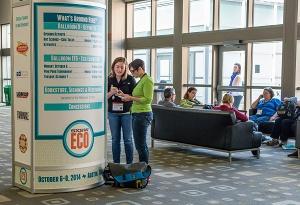

This post is part of Triple Pundit's ongoing coverage of the SXSW Eco conference. For the rest, please visit our SXSW Eco page here.
If you're anything like me, it was tough to step away from the computer during Climate Week NYC. Like so many others, I scrolled tirelessly through Twitter during the People's Climate March, which drew more than 400,000 supporters from all over the world in a hopeful foreshadowing of things to come. Then it was quickly on to live feeds of the United Nations Climate Summit, a historic gathering that promised to pave the way to a more sustainable future.
But last week as I strolled through the Austin Convention Center at the 2014 SXSW Eco conference, I overheard murmurings that the march and summit had disappeared from news feeds as quickly as they arrived -- that the media had all but forgotten the momentum supporters worked so hard to build.
Of course, just because a subject vanishes from the 24-hour news cycle doesn't mean it loses its footing at the forefront of the public agenda. For activists, supporters and, yes, even world leaders, the U.N. Climate Summit is still very much a hot topic. As a group of sustainability professionals, nonprofit leaders and reporters filed into a U.N. panel discussion at SXSW Eco, it was clear the summit still mattered a great deal to us. We all had one question on our minds: What happens next?
The summit did not disappoint in terms of its significance. More than 100 world leaders gathered and pledged commitments to help slow the pace of climate change. Twenty-eight governments, along with 35 top companies and nearly 100 other groups, signed the New York Declaration on Forests -- pledging to cut deforestation in half by 2020 and end it completely the following decade. Several European countries announced that they would target 40 percent greenhouse gas reductions over 1990 levels. China came in with a plan to cut carbon intensity by up to 45 percent by 2020 over 2005 levels. Closing the summit, U.N. Secretary-General Ban Ki-moon said, “I asked for bold announcements from governments, business, finance and civil society in five key areas. The summit delivered.”
Planners and delegates now look forward to the climate change conference in Lima in December and, ultimately, the 2015 gathering in Paris when it is hoped a global climate agreement will be reached. And while we knew all of this, the question on our minds was more philosophical. Rather than pondering what would happen next for U.N. climate delegates, perhaps more to the point we wondered: Is it for real this time?
The room was a diverse mix, with reporters who attended the first COP meeting in 1994 sitting side-by-side with those who had been too busy roller blading and writing letters to Santa Claus. But the quiet, cautionary skepticism was resounding. Is this latest climate summit just another Montreal? Another Copenhagen? Would interest briefly pique only to fizzle and die? Kalee Kreider, special advisor on climate science for the U.N. Foundation, touched on this sentiment almost immediately, saying:
"[The Climate March] was the first real moment I felt an end to the certain 'climate silence' that folks had experienced -- and sort of the frustration when the legislation in the U.S. collapsed and the Copenhagen Treaty talks didn't go so well. I really felt like folks had not only recuperated, but that there was something new and something different."
Andrew Freedman, senior climate reporter for Mashable who has been reporting on climate issues for nearly two decades, agreed: "As a jaded reporter who's been to Copenhagen and covered this stuff almost as long as [Kreider has], I came away from the New York summit with some sense of hope of where things are going."
One key distinction that separated this latest climate talk from those before it, Freedman pointed out, is that "it was a momentum summit; it wasn't a negotiating summit." With recent memories of marchers flooding the streets of New York as a backdrop, delegates and business leaders were free to discuss the subject openly -- and enter into voluntary commitments that hint at how far they're willing to go as talks move forward.
"What it was," Freedman said "was countries and companies signaling where they're thinking about going and how ambitious they're thinking in the near future." The sense of urgency presented by the march, he added, created a perfect storm that just may build momentum heading into Paris talks.
"The Climate March definitely gave Secretary-General Ban Ki-moon a lot of inspiration," he said. "I think he really felt it in his gut having marched with people that day to really ask leaders to be ambitious and courageous at that summit and heading into Paris. Because there's a sense that this is pretty much the last chance we have before we lock in enough infrastructure to take us well over the 2 degrees Celsius target that countries agreed to in Copenhagen. "It's clear where countries are going, and I think we're getting to a system where countries are coming to ambitious action on their own."
If the commitments made at the summit are any indication of what's to come, the cautiously optimistic among us can look forward to some big things coming out of Paris next year. Nevertheless, when it comes to this subject, optimism can be difficult. As the discussion drew to a close, a veteran climate action supporter with kind eyes and a soft smile stepped up to the microphone. She went on to say that she'd been in the climate action space since 1988 and at many times had despaired deeply about the global climate future. In closing, she asked a short but weighty question: "Can we actually turn this around?" Kreider's response shocked the room in a beautiful and unexpected way.
"The reason that I don't despair is that I want to keep us below 2 degrees Celsius. I don't know that we will; we may inflect higher than that. But I'll say this: I'm at the point where I got to see the Berlin Wall come down. I actually thought it was going to be there forever, but the wall came down and a lot of things changed. I won't go into the geopolitics of that only to say this: It can appear intractable."When the wall came down, retrospectively people said, 'Well there were all these indicators that change was coming.' I will say this to you: I actually think that there are a lot of indicators that change is happening. You see it in the solar and the wind industry. You see it actually at some companies. You see it on the streets of New York.
"I can't tell you when the wall is going to come down. I can't tell you at what temperature the wall is going to come down. I can't tell you what we might lose between now and when the wall is going to come down. But the wall will come down, and when the wall comes down we are going to be there. And the only way the wall is going to come down is if each and every one of us and everyone that we know helps to make that happen."
After a collective blink of disbelief, the room erupted into applause. And even as panelists answered the remaining questions, the sunny cloud of optimism left behind by Kreider's statement never faded. As we filed out of the room that day, we were left with a sense of hope and excitement of what's to come. Only time will reveal the results of the 2015 Paris summit. In the meantime all we can do is chant, "Tear down that wall!"
Image credit: Rebecca Hedges Lyon, courtesy of SXSW Eco
Based in Philadelphia, Mary Mazzoni is a senior editor at TriplePundit. She is also a freelance journalist who frequently writes about sustainability, corporate social responsibility and clean tech. Her work has appeared in the Philadelphia Daily News, the Huffington Post, Sustainable Brands, Earth911 and the Daily Meal. You can follow her on Twitter @mary_mazzoni.
It's High Time to Overhaul Water Pricing
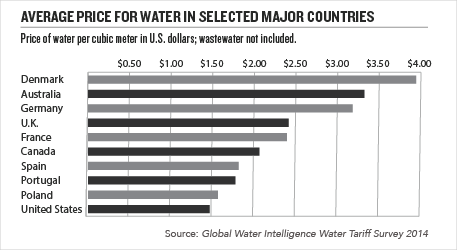

Recent water-related catastrophes in places like Toledo, Ohio, Los Angeles and West Virginia highlight an increasingly pressing need for the U.S. to make significant new investments in water resource infrastructure and management. They also cast light on outdated market structures and pricing mechanisms that result in counterproductive, even perverse, use and management of precious water resources.
In a recent article published by online environmental magazine Ensia, long-time water resource specialist, author and journalist Cynthia Barnett delves into the at-times murky world of the political economy of water in the U.S. “We're subsidizing our most wasteful water use – while neglecting essentials like keeping our water plants and pipes in good repair,” she writes.
How best to restructure water markets so as to make genuinely sustainable use of water resources is a controversial and hotly debated topic among economists, government leaders and agencies, as well as end users. More broadly, it raises the economic issue of how public goods – water, air, knowledge and national security, for example – are priced by markets and allocated among end users. In her article for Ensia, Barnett quotes Amsterdam-based water economist David Zetland, “You can get to sustainability, but you can't get there without putting a price on water.”
The political economy of U.S. water resource usage and management
Facing the possibility of a fourth year of drought, NASA recently published a satellite map showing the alarming extent to which California's groundwater resources – the crucial buffer for water supplies when rainfall falls short – are being depleted.
Per capita water usage in the U.S. has declining even as the U.S. economy and population have grown. Less water is used today in the U.S. than was the case 40 years ago as public awareness and widespread measures to increase efficiency – irrigation, water recycling on the part of commercial and industrial companies, and low-volume toilets, for example – have been adopted, Barnett points out.
Nonetheless, Americans continue to use more water, and pay considerably less for it, than most societies on the planet. Although it's the most precious of natural resources provided by U.S. utilities, it is also the least valued, Barnett notes. Poorly designed water policies and pricing are compounding the problem, leading to excessively wasteful use of water and disincentives for water utilities to invest in infrastructure, she continues. Further intensifying the issue is climate change, which causes changes in precipitation levels and seasonal patterns, according to scientists.
“Squeezed by drought, U.S. consumers and western farmers have begun to pay more for water. But the increases do not come close to addressing the fundamental price paradox in a nation that uses more water than any other in the world while generally paying less for it. And some of the largest water users in the East, including agricultural, energy and mining companies, often pay nothing for water at all,” Barnett writes.
Water policies and pricing mechanisms lead to wasteful use
The Gulf of Mexico "dead zone," the Duke Energy coal ash spill in West Virginia, the toxic algal bloom that shut down water supplies in Toledo, Ohio, and the burst water main that wasted 90 million gallons of water in Los Angeles are only a litany of developments that have brought the political economy of water resource management in the U.S. to the forefront of the public agenda. As Barnett puts it:
“The problems are also laying bare the flawed way we pay for water — one that practically guarantees pipes will burst, farmers will use as much as they can and automatic sprinklers will whir over desiccated aquifers...“Pennies-per-gallon water makes it rational for homeowners to irrigate lawns to shades of Oz even during catastrophic droughts like the one gripping California. On the industrial side, water laws that evolved to protect historic uses rather than the health of rivers and aquifers can give farmers financial incentive to use the most strained water sources for the least sustainable crops."
As one example, Barnett cites water usage and pricing near Yuma, Ariz. — the driest spot in the United States, with an average rainfall of 3 inches per year — where farmers use Colorado River water to grow alfalfa, a water-intensive crop. “Under the law of the river,” Barnett notes, “if they don’t use their allotment, they’ll lose their rights to it.”
Playing catch-up, municipalities around the U.S. have been raising water rates. Increases in cities' water rates have risen faster than the cost of living since 2007, but not fast enough to fund the estimated $1 trillion in projected new investments and repair costs for water resource infrastructure, Barnett continues.
The human right to clean water
Climate change is intensifying the need to restructure the political economy of water in the U.S. “Going forward, water infrastructure, supply and quality challenges intensified by the droughts, floods, temperature extremes and other influences of a changing climate will require new approaches to not only price, but also ethics: using less and polluting less, recycling more, and sharing costs among all users,” Barnett elaborates.
A public good essential to life, used and shared by all Americans, water markets are often opposed by human rights advocates, who argue that environmental goods and services that serve essential human needs should not be priced like commodities. While acknowledging this, Barnett believes water markets can be restructured in ways that meet the needs of all stakeholders, but do a much better job of allocation and producing the funds needed to make water infrastructure supplies sustainable and resilient.
“U.S. water use and price have been so skewed for so long that market solutions may be the only politically feasible way to right them. If we are to subsidize anyone, perhaps it should be the poor: A sustenance level of water for those who need it — free or dirt cheap — and higher prices for those who want more and choose to pay,” she writes. Barnett echoes University of Arizona law professor Robert Glennon, author of “Water Follies” and “Unquenchable: America’s Water Crisis and What To Do About It,” when she writes, “I argue for a human right to water. If we can’t guarantee that in the richest country in the world, we are a sorry lot.”
*Image credits: 1) Jacques Descloitres, MODIS Land Rapid Response Team, NASA/GSFC, January 2003; 2) NASA; 3) Global Water Intelligence Tariff Survey 2014.